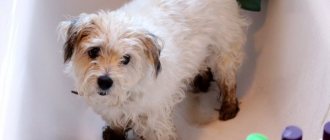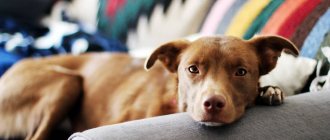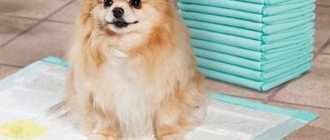Date: March 29, 2021
We have long perceived dogs living in the house as family members, involuntarily striving to “humanize” them a little. Four-legged pets are allowed to lie on the sofa, play with children and even climb into bed with their owners. There is a need for animal hygiene, because few people will enjoy dirt and a specific smell. And here we should be guided by the principle: “do no harm.”
Why do you need to bathe dogs periodically?
Bathing is a healthy procedure for your pet that prevents the appearance of possible skin diseases, lice and other parasites. It will also help get rid of unpleasant animal odor, which can irritate some people.
Dog taking a bath
It is necessary to wash your dog after a long walk in the evening, since dust and dirt instantly accumulate in the dog's fur. The pet is usually washed in the autumn or spring, when it is very dirty outside. The frequency of washing the animal depends on a number of conditions:
- breeds;
- activity;
- participation in exhibitions.
Typically, a dog is bathed no more than 1-2 times a month, regardless of whether it is a Chihuahua, Spitz, Husky or another breed. After each walk, it will be enough to wipe your pet’s paws and clean dirty areas of fur with a damp, clean cloth to remove minor dirt.
Before exhibition events, the furry pet is thoroughly washed, its coat is combed, giving it an aesthetic appearance. Representatives of long-haired breeds with soft fur are washed a little more often than short-haired ones. It is equally important to bathe the animal 2 days before the upcoming haircut. It will look beautiful on well-groomed, clean fur and the pet will not smell unpleasant.
Important! A veterinarian may prescribe a bath for a pet suffering from a fungal infection using special products that have a healing effect.
How often should you wash your puppy?
It is better to start bathing for the first time no earlier than when the puppy is 4 months old. Of course, necessity may force you to resort to bathing earlier, but then you need to take special care not to catch a cold. After bathing, he should be thoroughly dried with a towel and then placed in a warm place until his coat is completely dry.
As for how often a puppy can be washed, it depends on many factors:
- type and length of coat;
- weather;
- season;
- the place where the puppy is kept.
Since when bathing, the sebum that protects it from getting wet in the rain is washed off from the dog’s fur, immediately after bathing the puppy is vulnerable to bad weather for some time and can more easily catch a cold.
Bathing dogs is strictly prohibited for two weeks after vaccination.
On average, it is advisable to bathe a puppy once every couple of months, not more often.
Washing paws after every dog walk does not count. The water for washing should be at room temperature, but a little warmer is better. If your dog's paws are very dirty, you can use a little regular shampoo. Paws can be dried with a soft, hydrophilic cloth, working carefully but gently so as not to damage the skin between the animal's toes. If the dog manages to get dirty in paint, fuel oil or something else that cannot be washed off with water, then the soiled fur can be wiped with vegetable oil, but under no circumstances with any solvents. The most convenient way to wash the puppy is in the bathtub, into which you need to pour enough water so that it does not reach the animal’s body. Bath time should be far enough away from the next walk so that the puppy has time to dry completely by that time and not catch a cold. Usually this pause between washing and the next walk is 4 hours, but washing immediately after a walk is quite acceptable.
The process of washing a puppy
Now directly about how to wash the puppy. This is a rather complicated procedure that is best done together.
The washing process can be divided into 4 stages:
- Place a rubber mat on the bottom of the bath to prevent your puppy's paws from slipping. To wash the baby well, you will need a lot of warm water. Its temperature can be checked with a thermometer or the inside of your hand.
- Before applying shampoo, the puppy's coat should be thoroughly wetted down to the roots. Then you need to take a special shampoo for dogs, add a little water to it and foam it - in this form it is easier to apply without causing skin irritation. Next, carefully, without missing a single place, you need to rub in the shampoo. Usually they start from the dog's back, then moving to the chest, stomach, paws and anal area. You need to be especially careful when washing your puppy's head, making sure that shampoo does not get into the eyes and ears. You can close your ears ahead of time with oil-soaked cotton wool. Warm water has a relaxing effect on your dog's muscles, making it easier to clean his anal glands, located on both sides of the rectum and along it. Most dogs need to have these glands cleaned periodically.
- Then you need to thoroughly rinse the shampoo from the puppy's coat. You should start with the head, then the back and then the sides and stomach. You need to water your pet until the fur under your hand begins to creak. If the shampoo is not washed off well, the puppy will experience intense itching and dandruff. When rinsing is complete, it is advisable to squeeze out excess moisture from the wool with your hands. Special shampoos with antiparasitic properties should be used only if fleas are present, and they should be washed off even more thoroughly so that the remaining caustic components do not cause skin irritation.
- After completing the water procedures, the puppy must be thoroughly dried. The main water can be collected with cotton towels while the puppy remains standing in the bath. If he has long and thick fur, then it is best to use a hairdryer. Drying usually starts from the hind legs, moving gradually towards the head.
Dogs usually shed a little after bathing, especially in breeds with undercoat. This circumstance must be taken into account by the dog owner who intends to take his pet into the show ring in the near future. In preparation for this, you will need to comb and brush your dog daily.
Video on how to wash a puppy
Grooming and bathing a Yorkshire Terrier puppy
From the point of view of the puppy’s body, bathing is a dangerous intervention in its vital functions. Therefore, compared to an adult dog, it needs to be washed less often so as not to catch a cold. In addition, a full bath is not necessary; it is enough to rinse the contaminated part of the body with warm water, wipe it with a napkin or dry it with a hairdryer, then brush it - and the puppy is clean.
After being washed, your Yorkie's coat becomes dull due to loss of oil. A dog has very delicate skin, since it is constantly protected by a thick coat, so if the shampoo is not washed off well, scratching and irritation may appear on it.
Some owners who are overly concerned about the cleanliness of their puppies tend to wash them with shampoo or soap without any reason. But from frequent washing, the wool only loses its shine, and the skin becomes dry and begins to peel. Dry skin causes anxiety and itching for the dog who scratches it, even to the point of bald patches. Regular use of detergents destroys the protective layer of fat on the dog’s skin and coat, but it is the secretions of the sebaceous glands that make the Yorkie’s coat so shiny and resistant to moisture, protects it from the penetration of microorganisms and from hypothermia.
To keep your Yorkie puppy's fur sufficiently clean, it is enough to brush it regularly with a brush and comb. Dirt does not stick to the fur due to lubricant, so it is removed with the fallen hairs. Even if you don’t wash a puppy with shampoo for three months, then its skin will be no dirtier than a human’s. You can verify this if you run one cotton swab moistened with water over the dog’s fur, and the other along your elbow and simply compare the results. Therefore, puppy detergents should be used only when necessary and as rarely as possible. Even with water, you should not rinse it too often. If, for example, when feeding a Yorkshire terrier puppy, he was careless and dirty not only his face, but also his paws and ears, then it is better not to wash off the remaining food with water, but simply wipe the dirty areas with a terry towel, and then comb them thoroughly. In general, dog hair is surprising in its ability to clean itself.
Until the age of 6 months, a puppy should not be washed with shampoos at all, but it is better to use a mixture of a glass of kefir, yolk and half a glass of water. It is advisable to wash your puppy with this natural shampoo, since it does not remove the fatty layer from the coat.
How often and what do you wash your puppy with? Tell us about it in the comments.
At what age can you bathe?
How to properly train a dog at home
Experts recommend starting to wash your pet for the first time at three months of age. However, not everything is so simple. There are many factors that determine when and how to wash your puppy. As a rule, a newborn puppy is licked by its mother. If it is not there, then you can wipe the baby with a damp cloth.
The little pet could initially live on the street. If this is the case, then regardless of age, it is better to wash it and, if necessary, use an anti-flea drug. Otherwise, infectious diseases will enter the house along with the puppy.
Appearance of a three month old puppy
Puppies are usually purchased from breeders at the age of 3 months. The acquired pet must first get used to its new place of residence. For this he will need at least 2 weeks. After this period, you can begin your first bath.
Preparing for a swim
- Getting to know the bathroom. Take the puppy into the bathroom, play with him there, and let him sniff everything. Once your four-legged friend is comfortable, place him in the bathtub or sink without water. Give him time to get used to the new surroundings and smells;
- Getting used to water. Pick up your puppy, turn on the faucet, and let your puppy get used to the sound of running water and splashing. Don't forget to play and talk to your baby all the time;
- Prepare your puppy's bathing supplies. Before the bath procedure, prepare in the bathroom a diaper or a special rubber mat, shampoo for dogs (buy at a pet store, shampoos for humans are absolutely not suitable for bathing dogs), a towel, a ladle, a container for clean water;
- Choose a swimming spot and prepare it. Depending on the size of your pup, choose a bathtub, sink, or basin. It is more convenient to bathe small puppies in the sink. Place a diaper at the bottom of the bathtub or sink to prevent your puppy from slipping and injuring himself during the bath. Fill a separate container with warm water to rinse the shampoo off the puppy;
- Create a calm stop. Make sure that no one bothers you while bathing your puppy and that the bathing procedure does not turn into a circus performance. Crowds of household members and noisy cries can frighten the puppy;
- Do everything with confidence. Dogs are sensitive to the mood of their owners. So if you get nervous, your puppy will get nervous too. While bathing, talk to him, praise and pet him. You can put your pet's favorite toy in the bathtub or sink;
- Wear comfortable clothes. Be prepared for your puppy to repeatedly shake off splashes of water while bathing. Therefore, wear clothes that you don’t mind getting wet and dirty;
- Create comfortable conditions for swimming. If it is cold in the house or bathroom during the bath procedure, the puppy may catch a cold. Therefore, make sure that the house is warm. Bathing water should be about 37 Cᴼ. Fill the bathtub or sink with warm water until it reaches your puppy's chest;
- Choose the right time. Bathe your puppy no earlier than 1 hour after eating or 2 hours before eating. Try to have your pet relieve itself before bathing. It is best to bathe your puppy after an active walk. You will be able to cope with a tired pet more easily;
- Close the bathroom doors. When everything you need for bathing is ready, take the puppy in your arms, go into the bathroom and close the door so that the puppy does not run away and no one disturbs you.
Why you shouldn't wash your dog too often
It is not recommended to bathe your dog too often. Otherwise, the animal’s natural fatty lubricant, which protects the skin from cracking and dryness, will disappear. In the short period of time between bathing, the fat film is not able to recover.
What to feed your dog at home and how to do it correctly
Frequent bathing of a pet using special detergents is especially harmful. The dog may experience itching and an allergic reaction.
Other unpleasant consequences:
- the occurrence of dandruff;
- the appearance of wounds and scratches;
- rapid hair loss;
- producing more fat.
Important! The dog much more often rolls around in the grass or in the ground, trying to regain its natural smell after bathing.
If you can’t wash the dirt off your dog the first time, you will have to repeat the procedure.
However, if you bathe your pet once every ten days, then there will be no problems with dirt. Dog breeders do not recommend bathing more often, since the dog’s skin is naturally, through the pores, lubricated with fat, which protects it from drying out. And if you bathe your pet too often with the wrong shampoo, you can end up with a serious skin disease.
Much, of course, depends on the breed, but in some cases it is recommended, in addition to regular bathing, to also care for the dog’s skin and coat using special oil, which is also sold in any veterinary store.
How to properly wash at home
Is it possible to wash a dog with tar soap or laundry soap?
Every dog owner should know how to wash a dog without harming it. First you need to fill the bath with warm water, the temperature of which should not exceed 40 degrees. You need to prepare towels, hygiene products and a comb in advance.
Step-by-step diagram of how to bathe a dog in the bath:
- Wet the body except the head and groin area.
- Dilute the shampoo with water to form dense foam. Thoroughly rub soap suds into the fur all over the back, and then apply it to the paws, tail, neck and belly. Afterwards, you can soap the dog’s hair, being careful not to get the mixture into the ears and eyes.
- Maintain the soap composition for 3-5 minutes, and then rinse it off with clean water. Lather the fur one more time and rinse again. Completely remove the cleanser from the head, then the back, neck and sternum.
- Dry the dog with a microfiber towel.
Washing a dog in the bathroom
Comb the bathed animal with a comb.
Important! You can put cotton swabs in your pet's ears. This will help prevent water from getting inside. This is done before bathing the dog.
How to properly apply shampoo to dog hair
The required amount of shampoo must first be diluted in warm water. To do this, you can use some small container - a cup, for example, plastic or enamel. But I use a very convenient shampoo bottle with a non-spill cap.
Of course, I washed the bottle very carefully so that there was no old shampoo left in it.
If the dog is very small, you can bathe it in a basin with warm water. If it’s larger, then a shower with a flexible hose will do. To prevent the dog from being frightened by the jets of water, the shower head should be kept as close to the dog’s body as possible.
The water temperature is 30-35 degrees, a little cooler than where you would bathe a child.
After wetting the dog's fur, you need to apply a small amount of shampoo diluted in water to different parts of the body - a little drop on the head, on the paws, back, sides, tummy. And then, of course, whip up the foam with your fingers and rub the wool thoroughly to wash off the dirt.
Next, of course, rinse the shampoo very thoroughly with water. Make sure that no foam or soap solution remains on the dog’s fur under any circumstances.
How can you wash your dog?
Choosing the wrong detergent for your dog can cause deterioration of the coat, dermatitis, eczema and dermatosis. Therefore, it is equally important to know how to wash your dog. Human shampoo is not suitable for a dog, since the animal’s skin is different from the human epidermis. You should not use laundry soap and various folk remedies so as not to spoil your pet’s skin.
The pet is washed with special products for dogs. List of things you can use to wash your dog:
- cosmetic shampoos and liquid soaps that remove dirt and are suitable for frequent use;
- hypoallergenic shampoos for pets suffering from allergies to cosmetics;
- medicated shampoos against fleas, ticks, fungus and bacteria as prescribed by a doctor;
- tar soap to repel parasites.
Important! After using tar soap, you will have to deal with an unpleasant odor. It will disappear only after 2-3 hours.
You need to prepare in advance - towels, soft rags, dog shampoo
Nowadays you can buy shampoo suitable for any type of dog hair at the pet store. I buy my baby a shampoo that prevents the formation of tangles and dandruff. Now there are no problems with tangles! The coat is soft, fluffy, and very easy to comb. And it stays like this for quite a long time, almost until the next swim. It doesn't even get dirty as much as before.
By the way, if you still don’t have dog shampoo on hand, it’s better not to use colored and flavored human shampoos. Dogs do not tolerate perfume very well. Their sensitive sense of smell cannot tolerate the pungent odors of perfumes and all kinds of fragrances used in human cosmetics. This is a real mockery of canine nature...
My baby, for example, absolutely cannot stand people who wear perfume excessively. Recently, on the street, she simply rushed at one person, barked indignantly, literally chased him on his heels, I could barely keep her on a leash. At first I couldn’t understand where this reaction came from, but then I figured it out. The man literally smelled wildly of some cheap perfume. The smell was extremely pungent and intrusive. What if it wasn't my dog? What about some young, not yet very well-trained, large breed dog that is kept on a leash by a child? Who will be to blame in such a situation?
Dog smell - how to get rid of it
An unpleasant dog odor may appear due to violations of maintenance standards or problems in the body. A healthy dog doesn't stink.
Ways to combat dog odor:
- carrying out wet cleaning of the house every 7 days;
- washing dog beds;
- cleaning ears of lop-eared breeds;
- eliminating junk food from the dog’s diet;
- using deodorants for dogs;
- cleaning your pet's tail;
- wiping the wool with a weak solution of water and vinegar once a month;
- brushing teeth with special brushes and pastes.
It is better to use all of these methods in a comprehensive manner, without relying on the effectiveness of only one of them.
Important! Human deodorants and perfumes should not be used to combat dog odor.
How to wash a dog if he is afraid
To prevent your dog from experiencing fear of water, you must follow the following recommendations:
- Accustom to water from childhood by wiping the fur with a damp sponge.
- Give a favorite treat or a toy before and after washing.
- Pet, praise and talk to her in a calm voice while washing.
- Make the water pressure not very strong, gradually increase as needed.
All of the above must also be taken into account before washing your dog in the bath. Over time, she will no longer be afraid of water procedures.
Dry bathing
When a dog cannot be washed in water with shampoo, dry bathing is used. It is carried out using dry shampoo. This is a powder applied to the roots. They cover the fur, which is then massaged and combed out. It sucks out excess fat. The pet is washed in a similar way in winter, when the house is cold and the fur takes a long time to dry.
Trixie Dry Shampoo for Dogs
Drying wool
After bathing, you first need to wring out the fur with your hands. After taking your dog out of the bath, you should let him shake himself off. Then you can dry your pet's fur with a towel using gentle movements and comb it.
The fastest way to dry is using a hair dryer. But this method is not suitable for all individuals. The animal may be frightened by a noisy device. There is no need to force him if he doesn't like the hairdryer. The dog should remain at home until the fur is completely dry.
Now the pet owner knows how to wash a dog at home correctly. It's better to do this with someone together.










